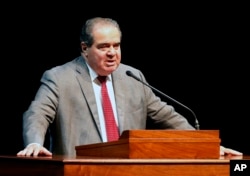Who did President Obama nominate?
President Barack Obama nominated Judge Merrick Garland to fill the seat left vacant by the death Justice Antonin Scalia. Garland has served on a lower Federal court for 19 years. Obama called him “one of the sharpest legal minds” with a long history of service in his profession.
According to the Constitution, presidents “shall nominate, and by and with the Advice and Consent of the Senate, shall appoint ... Judges of the Supreme Court.”
Decades of tradition have grown up around the process described in the Constitution, adding many more steps before a nominee can be confirmed and sworn in as a Supreme Court justice.
“There’s actually very little that the Constitution has to say about the politics, about why the Senate might choose to approve or reject a particular nominee or – more importantly – how quickly the Senate might choose to approve or reject a nominee,” said Steve Vladeck, Professor of Law at the American University College of Law.
“There’s tradition and there’s practice but there are very few hard and fast Constitutional rules.”
What’s the difference between a nomination and an appointment?
The president nominates, the U.S. Senate confirms the nomination, and then the Justice is appointed and sworn in. Because Supreme Court justices hold lifetime appointments and are confirmed by two branches of the U.S. government – the legislative and executive – their appointments have a special significance in the process of government.
What happens next?
The president’s nomination goes to the Senate, where the Judiciary Committee holds a hearing with the nominee. This is an opportunity for the nominee to testify about his or her experience and judicial approach. Traditionally, the nominee is not asked to provide views on specific issues.
“The idea is that the Judiciary Committee is in a better position to take evidence, to take testimony, basically to do research and to then make a recommendation to the full Senate,” said Vladeck.
The committee then refers the nomination to the full Senate for a vote.
Is the confirmation process different in a presidential election year?
Legally, this process isn’t different in an election year. The U.S. Constitution does not make a distinction between Supreme Court appointments in an election year versus any other year.
But Mitch McConnell, the Senate Majority leader, said shortly after the death of Justice Scalia that the U.S. Senate should not act to fill the vacancy on the Supreme Court until a new president takes office early next year.
“The American people should have a voice in the selection of their next Supreme Court Justice. Therefore, this vacancy should not be filled until we have a new president,” he said.
President Obama addressed this issue, saying “Presidents do not stop working in the final year of their term; neither should a senator.”
How will this time be different?
Many Republicans say they will not hold a hearing for Garland. Even if they do hold hearings, the Senate could refuse to hold a full vote and hold up the nomination until after the “lame duck” period — this is the time period between the November presidential election and next January when the new president is sworn into office.
Analysts says Senate Republicans could wait to see if someone from their own party is elected and hold up the nomination until that time. If Bernie Sanders or Hillary Clinton is elected president on the Democratic side, they could pick an even more liberal nominee than Garland. In that case, analysts say Garland — who is perceived by many as a moderate — could then face a full vote in the Senate and receive confirmation.
“Again, it’s not the Constitution that’s doing the work here — it’s the political climate,” said Vladeck. “The real question here is, can the Senate go the better part of a year without providing a process?”
What are Americans saying about the process?
62 percent of registered voters said the Senate should consider Garland's nomination, according to a March 2016 Quinnipiac University poll.
Do current Supreme Court justices have any say in the process?
Current Supreme Court justice do not have any constitutional role in selecting a new Justice.
Vladeck said the justices refrain from commenting on the confirmation not because “they don’t feel very strongly about the Court or the process or the nominee, but because they see it as their role to stay neutral during the whole process and to let the Senate do its job.”
But just days before Justice Scalia died, Chief Justice Roberts said the Supreme Court nomination process had become too politicized.
“We don’t work as Democrats or Republicans and I think it’s a very unfortunate impression the public might get from the confirmation process,” said Roberts.
Can the Senate reject a nominee?
About 20 percent of all Supreme Court nominees failed to achieve Senate approval. The last time the full U.S. Senate rejected a presidential nominee was in 1987 while Ronald Reagan was in office.
How long does the process last?
Since 1975, the entire process has lasted about two-and-a-half months, but that could change this time because of election year politics.
Vladeck said, “To have this process stretched out not just over four months — which is the record — but actually over the entire course of this election year, I think would be unprecedented.”











